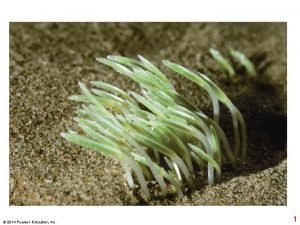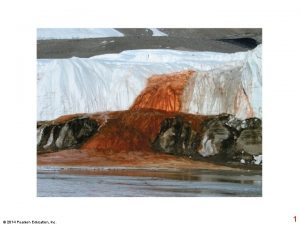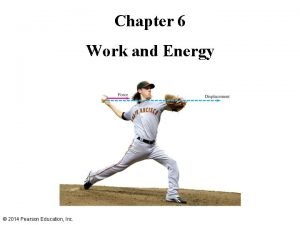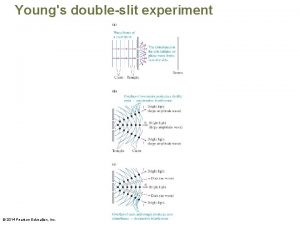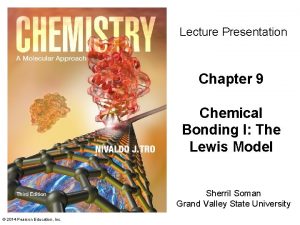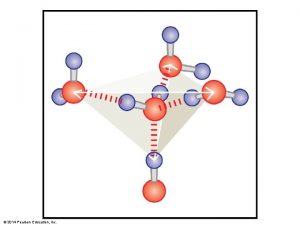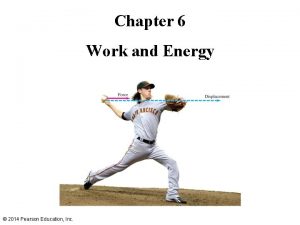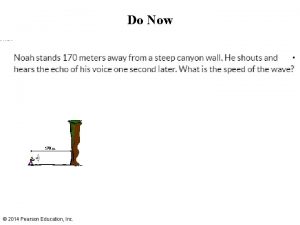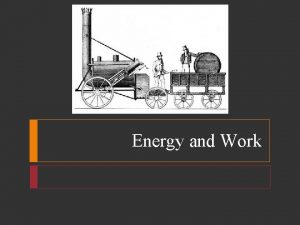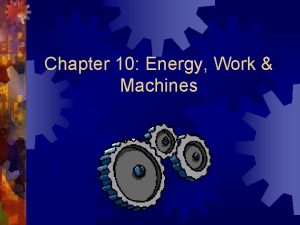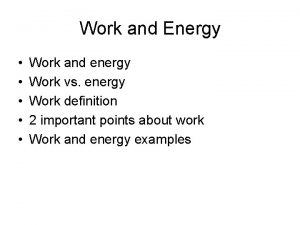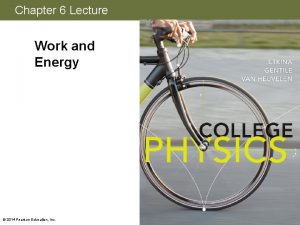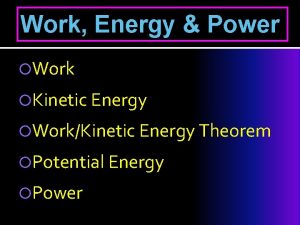Chapter 6 Work and Energy 2014 Pearson Education

















- Slides: 17

Chapter 6 Work and Energy © 2014 Pearson Education, Inc.

Contents of Chapter 6 • Work Done by a Constant Force • Work Done by a Varying Force • Power © 2014 Pearson Education, Inc.

6 -1 Work Done by a Constant Force The work done by a constant force is defined as the distance moved multiplied by the component of the force in the direction of displacement: (6 -1) © 2014 Pearson Education, Inc.

6 -1 Work Done by a Constant Force In the SI system, the units of work are joules: 1 J=1 N·m As long as this person does not lift or lower the bag of groceries, he is doing no work on it. The force he exerts has no component in the direction of motion. © 2014 Pearson Education, Inc.

6 -1 Work Done by a Constant Force Solving work problems: 1. Draw a free-body diagram. 2. Choose a coordinate system. 3. Apply Newton’s laws to determine any unknown forces. 4. Find the work done by a specific force. 5. To find the net work, either find the net force and then find the work it does, or find the work done by each force and add. © 2014 Pearson Education, Inc.

6 -1 Work Done by a Constant Force Work done by forces that oppose the direction of motion, such as friction, will be negative. Centripetal forces do no work, as they are always perpendicular to the direction of motion. © 2014 Pearson Education, Inc.

Solving work problems: 1. Draw a free-body diagram. 2. Choose a coordinate system. 3. Apply Newton’s laws to determine any unknown forces. 4. Find the work done by a specific force. 5. To find the net work, either find the net force and then find the work it does, or find the work done by each force and add. Problem solving steps(shown above): 1. 2. Crate is moving horizontally so we choose the x direction. There are 4 forces acting on the crate but we are only concerned with the ones acting in the x direction since we know that the ones acting in y direction will cancel out. 3. Both horizontal forces are know (Fp and Ff) 4. W done by pulling force (Fp): W=FdcosƟ=100 N (40 m) cos 37=3195 J W done by friction(Ff): W=Fd=-50 N(40 m)=-2000 J 5. Net work=The sum of all the works Wnet = Fp + Ff = 3195 J + -2000 J = 1195 J © 2014 Pearson Education, Inc. Example 6 -1 A 50 kg crate is pulled 40 m along a horizontal floor by a constant force exerted by a person, Fp=100 N, which acts at a 37◦ angle as shown. The floor is rough and exerts a friction force Ff=50 N. Determine the work done by each force acting on the crate, and the net work done on the crate.

Solving work problems: 1. Draw a free-body diagram. 2. Choose a coordinate system. 3. Apply Newton’s laws to determine any unknown forces. 4. Find the work done by a specific force. 5. To find the net work, either find the net force and then find the work it does, or find the work done by each force and add. Problem solving steps(shown above): 1. 2. Backpack is moving vertically so we choose the y direction. 2 forces acting on the backpack in the y direction (Fg and Fh). . There are 3. Since the backpack isn’t accelerating, we know the Fnet =0 N. So Fg=Fh =mg=15 kg(9. 8 m/s 2) = 147 N. 4. a) W done by hitchhiker(Fh): W=Fd=147 N (10 m) =1470 J b) W done by gravity(Fg): W=Fd=-147 N(10 m)=-1470 J 5. Net work=The sum of all the works Wnet = Fg + Fh = 1470 J + -1470 J = 0 J © 2014 Pearson Education, Inc. Example 6 -2 a) Determine the work a hiker must do on a 15. 0 kg backpack to carry it up a hill of height h=10. 0 m, as shown. Determine also b) the work done by gravity on the backpack, and c) the net work done on the backpack. For simplicity, assume the motion is smooth and at constant velocity (acceleration is zero).

Example 6 -3 Q: The Moon revolves around the Earth in a circular orbit, kept there by the gravitational force exerted by the Earth. Does gravity do positive, negative, or no work on the moon? A: Force is perpendicular to distance so there is no work being done. This is why no fuel is needed to keep satellites (etc. ) in orbit. © 2014 Pearson Education, Inc.

6 -2 Work Done by a Varying Force For a force that varies, the work can be approximated by dividing the distance up into small pieces, finding the work done during each, and adding them up. As the pieces become very narrow, the work done is the area under the force vs. distance curve. © 2014 Pearson Education, Inc.

Put example in Journal a) Find the area for each section Area of triangle = 1/2 bh Area of rectangle =bh 1) (400 N x 3 m)/2 = 600 J 2) 400 N x 4 m = 1600 J 3) (400 N x 3 m)/2= 600 J Add to get total: 600 J + 1600 J + 600 J = 2800 J b) Find the area for each section Area of triangle = 1/2 bh Area of rectangle =bh Since we found from 0 -10 m in part A, we find the rest for part b and add. 1) (-200 N x 1. 5 m)/2 = -150 J 2) -200 N x 2 m = -400 J 3) (-200 N x 1. 5 m)/2= -150 J Add to get total: -150 J + -400 J + -150 J = -700 J Total for 0 -15 m: 2800 J-700 J=2100 J © 2014 Pearson Education, Inc. Q) The force on a particle, acting along the x axis, varies as shown in Fig. 6 -38. Determine the work done by this force to move the particle along the x axis: a) from x =0. 0 to x=10. om; b) from x=x=0. 0 to x=15. 0 m.

6 -10 Power is the rate at which work is done— (6 -17) In the SI system, the units of power are watts: 1 W = 1 J/s The difference between walking and running up these stairs is power— the change in gravitational potential energy is the same. © 2014 Pearson Education, Inc.

6 -10 Power is also needed for acceleration and for moving against the force of gravity. The average power can be written in terms of the force and the average velocity: (6 -18) © 2014 Pearson Education, Inc.

Example 6. 16(pg. 16) Q) A 60 kg jogger runs up a long flight of stairs in 4. 0 s. The vertical height of the stairs is 4. 5 m. A) Estimate the jogger’s power output in watts and Horsepower. B) How much energy did this require? Note: The example on the handout uses 70 kg instead of 60 kg. A)Given: m=60 kg; h=4. 5 m; t=4. 0 s Formula: Power = Work/time=Fd/t = mad/t Jogger is moving against gravity so you would use 9. 8 m/s 2 as your acceleration. Substitution: 60 kg (9. 8 m/s 2) 4. 5 m = 2646 J = 4. 0 s Answer w/unit: 662 W Convert to horsepower: 1 hp = 746 W 662 W x 1 hp = 0. 887 hp 746 W B) Energy = Pt = 772 W (4. 0 s) = 3088 J © 2014 Pearson Education, Inc.

Example 6. 18(pg. 17) A)Given: m=1400 kg; Ɵ=10◦; v=80 km/h *Convert 80 km/h to m/s to get a speed of 22. 2 m/s (the speed you use in the equation) *To move up a steady speed, the car must exert a force equal to the sum of Fr and Fgx =mgsin 10◦=2382 N FA= Fr + Fgx = 700 N + 2382 N = 3082 N Q) Calculate the power required of a 1400 kg car under the following circumstances: a) The car climbs a 10◦ hill at a steady 80 km/h b) The car accelerates along a level road from 90 to 110 km/h in 6. 0 s to pass another car. Assume a retarding force(Fr)on the car of 700 N throughout. (This force is more about air resistance than friction) © 2014 Pearson Education, Inc. Formula: Power = Work/time=Fd/t = Fv Substitution: 3082 N (22. 2 m/s) = Answer w/unit: 68420 W Note: Part B continues on next slide.

Example 6. 18(pg. 17) B) Given: vo = 90 km/h; v=110 km/h; t=6. 0 s *Convert 90 km/h and 110 km/h to m/s to get a speed of 25 m/s and 30. 6 m/s (the speeds you use in the equation) *To accelerate up the hill, the car must exert a force equal to the sum of Fr and Fnet = ma=m∆v/t=1400 kg(30. 6 m/s-25 m/s) =1307 N 6. 0 s FA= Fr + Fnet = 700 N + 1307 N = 2007 N Q) Calculate the power required of a 1400 kg car under the following circumstances: a) The car climbs a 10◦ hill at a steady 80 km/h b) The car accelerates along a level road from 90 to 110 km/h in 6. 0 s to pass another car. Assume a retarding force(Fr)on the car of 700 N throughout. (This force is more about air resistance than friction) © 2014 Pearson Education, Inc. Formula: Power = Work/time=Fd/t = Fv Substitution: 2007 N (30. 6 m/s) = Use 30. 6 m/s because the power is dependent on the force needed to get it to that speed. Answer w/unit: 61414 W

Summary of Work & Power • Work: W = Fd cos θ • Power is the rate at which work is done. © 2014 Pearson Education, Inc.
 2014 pearson education inc
2014 pearson education inc 2014 pearson education inc
2014 pearson education inc 2014 pearson education inc
2014 pearson education inc 2014 pearson education inc
2014 pearson education inc 2014 pearson education inc
2014 pearson education inc 2014 pearson education inc
2014 pearson education inc Water cycle pearson education
Water cycle pearson education 2014 pearson education inc
2014 pearson education inc 2014 pearson education inc
2014 pearson education inc 2014 pearson education inc
2014 pearson education inc 2014 pearson education inc
2014 pearson education inc 2014 pearson education inc
2014 pearson education inc Pearson education
Pearson education 2014 pearson education inc
2014 pearson education inc 2014 pearson education inc
2014 pearson education inc 2014 pearson education inc
2014 pearson education inc 2014 pearson education inc
2014 pearson education inc 2014 pearson education inc
2014 pearson education inc





